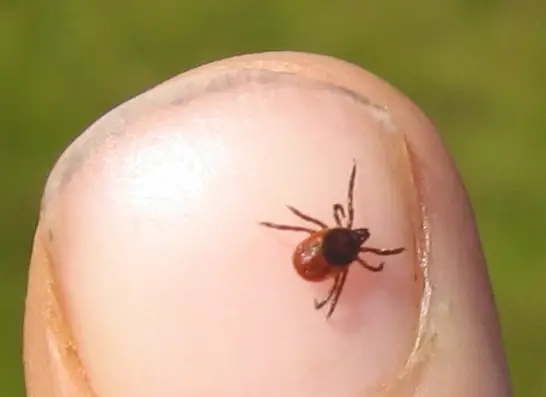If you’re an outdoor enthusiast, you’re likely familiar with the threat of ticks. These tiny blood-sucking insects can transmit a variety of diseases, including Lyme disease, which can cause serious health problems if left untreated. One common question people have is: do ticks come off in the shower?
While it’s true that showering can help wash away unattached ticks and give you an opportunity to do a tick check, it’s not a foolproof method for removing ticks. In fact, once a tick has latched onto your skin and started feeding, it can be difficult to remove, even with soap and hot water.
So, what should you do if you find a tick on your skin? And how can you prevent tick bites in the first place? In this article, we’ll take a closer look at the topic of ticks and showering, and provide some tips for staying safe and tick-free while enjoying the great outdoors.
Understanding Ticks

What Are Ticks?
Ticks are small arachnids that feed on the blood of animals, including humans. The most common species of ticks in North America are the blacklegged tick (also known as the deer tick) and the dog tick. Ticks are most active during the warmer months but can be found year-round in some areas.
How Do Ticks Attach Themselves To Humans?
Ticks use their mouthparts to bite into human skin and attach themselves. They prefer areas where the skin is thin and tender, such as the armpits, groin, and scalp. Once attached, ticks feed on the blood of their host. The longer they feed, the higher the risk of transmitting diseases like Lyme disease, Rocky Mountain spotted fever, and Powassan virus.
It’s important to note that not all ticks carry diseases and not all tick bites result in illness. However, it’s still important to take precautions to avoid tick bites. After spending time outdoors, it’s recommended that you check yourself and your pets for ticks.
Tick Removal Methods
Why Removing Ticks Is Important?
It is important to remove ticks as soon as possible to reduce the risk of contracting tick-borne diseases like Lyme disease. The longer a tick stays attached, the higher the likelihood of disease transmission. Therefore, it is crucial to remove ticks promptly and correctly.
How To Remove Ticks
The Centers for Disease Control and Prevention (CDC) recommends the following steps to safely remove ticks:
- Use clean, fine-tipped tweezers to grasp the tick as close to the skin’s surface as possible.
- Pull upward with steady, even pressure. Don’t twist or jerk the tick; this can cause the mouth-parts to break off and remain in the skin. If this happens, remove the mouth-parts with tweezers.
- After removing the tick, clean the bite area and your hands with rubbing alcohol or soap and water.
- Dispose of the tick by flushing it down the toilet or placing it in a sealed bag or container.
Here’s a great video tutorial from the University of Maine on how to safely remove a tick:
Do Ticks Come Off In The Shower?
Although showering may help to dislodge ticks, it is not a reliable method of tick removal. Ticks have strong mouthparts that allow them to firmly attach to the skin, and they can remain attached even when exposed to water. Therefore, it is not safe to rely on showering to remove ticks.
Will Ticks Die When I Shower?
Showering alone is not enough to kill ticks. Ticks die in hot environments, but the temperature of the average shower is not high enough to kill them. Even though most residential hot water tanks are set over 140 degrees, the average shower temperature is 112 degrees. Therefore, it is not safe to rely on showering to kill ticks.
Showering may help reduce the risk of Lyme disease
While showering alone is not enough to remove or kill ticks, it can still help to reduce the risk of Lyme disease. Showering within two hours of being outdoors can help to wash away any unattached ticks and reduce the risk of disease transmission. Additionally, it is important to thoroughly check the body for ticks after spending time outdoors and to remove any ticks promptly and correctly.
Prevention of Tick Bites

How to Avoid Tick Bites?
Ticks are most commonly found in wooded areas or areas with tall grass. To avoid tick bites, it is recommended that you take the following steps:
- Wear long-sleeved shirts and pants when spending time outdoors, especially in wooded or grassy areas.
- Tuck your pants into your socks or boots to prevent ticks from crawling up your legs.
- Use insect repellent that contains at least 20% DEET on exposed skin and clothing.
- Shower within two hours of coming indoors to wash off any unattached ticks and perform a thorough tick check.
- Avoid walking through tall grass or brush and stick to the center of trails when possible.
What Should You Do After Being Bitten by a Tick?
If you find a tick attached to your skin, it is important to remove it as soon as possible. Follow these steps to safely and effectively remove a tick:
- Use fine-tipped tweezers to grasp the tick as close to the skin’s surface as possible.
- Pull upward with steady, even pressure to remove the tick. Do not twist or jerk the tick as this can cause the mouthparts to break off and remain in the skin.
- After removing the tick, clean the bite area with rubbing alcohol or soap and water.
- Dispose of the tick by flushing it down the toilet or placing it in a sealed bag or container.
- Monitor the bite area for any signs of a rash or infection, and seek medical attention if you experience symptoms such as fever, headache, or muscle aches.
By taking these preventative measures and knowing how to safely remove a tick, you can reduce your risk of tick-borne illnesses such as Lyme disease.
Conclusion
Showering after being outdoors is an effective way to reduce the risk of tick bites and tickborne diseases. It is important to check your body for ticks after being outdoors and remove any attached ticks promptly. However, if a tick has already dug into the skin, showering will not wash it off.
It’s important to note that no amount of soap and hot water at a typical shower temperature will kill a tick that has already attached itself to your skin. Therefore, it is important to use proper tick removal techniques to remove an attached tick.
Showering may help wash off unattached ticks, especially male ticks, which are less likely to attach to the skin. However, it is important to note that showering alone is not a substitute for other tick prevention measures, such as wearing protective clothing and using insect repellent.
In summary, showering within two hours of coming indoors is a good opportunity to check for ticks and wash off any unattached ticks. However, if a tick has already attached to the skin, it will not be washed off by showering. Proper tick removal techniques should be used to remove an attached tick.
Check out our other helpful camping guides while you’re here:
The Best Canned Foods For Camping

